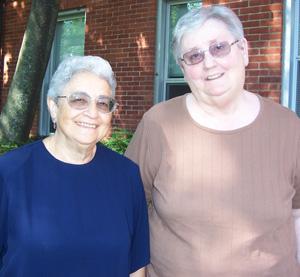
By Celine Klosterman
DAVENPORT — Having bilingual “bridge people,” holding cross-cultural parish activities and simply offering a sense of welcome can help unite parishioners of different cultures. Those are ideas eight participants picked up during an event presented Sept. 2 by two Sisters of the Humility of Mary.
“Are There Ghettos in Our Parishes?,” held at the Humility of Mary Center in Davenport, offered an opportunity for discussion and gave practical suggestions for managing multicultural parishes. Sister Caridad Inda, CHM, and Sister Kathryn Bissell, CHM, who led the workshop, are founders and co-directors of The Center for International Resources Inc. (CIRIMEX) in Guadalajara, Mexico, which offers Spanish-language and cultural immersion training.
In a ghetto, people live and communicate only with other members of their group, Sr. Bissell told members of Sacred Heart Cathedral and St. Mary Parish in Davenport, St. John Vianney Parish in Bettendorf and the Congregation of the Humility of Mary. Such a situation deprives the larger community of people’s gifts, observed attendee Sister M. Johanna Rickl, CHM.
Unfortunately, parishioners can feel threatened by newcomers with different cultural backgrounds, Sr. Bissell said.
But attendee Rita Cunningham, a member of Sacred Heart Cathedral in Davenport, pointed out similarities between Catholics of varying backgrounds. “When we get to know people of different cultures we find that they essentially want the same things we do — for example, to grow in their faith, to make a living and to see that their children are well educated.”
Later in the workshop, during discussion of the language barrier, attendee Terry Strader of St. Mary Parish in Davenport said her largely Hispanic parish relies heavily on a few bilingual interpreters. Such “bridge people” are vital, Sr. Inda said. Some priests fit that description, but lay people are also necessary.
Even if Catholics learn English as a second language, they often prefer to attend Mass celebrated in their native tongue, Sr. Bissell said. “That’s where you feel at home,” said attendee Rosanna Vigliotti, an Italian immigrant and member of St. John Vianney Parish in Bettendorf.
Lack of integration creates a “shared parish,” Sr. Bissell said. Separation also can lead to fear, divided loyalties and lack of common goals, Sr. Inda said.
She later suggested variables to consider when trying to bridge groups of different cultures: how long immigrants have been here, how much English they know, how much exposure they’ve had to U.S. society and whether “bridge people” are easily available. Bridge parishioners “are always there; you just have to find them and maybe convince them” to help, she said.
In addition to finding Catholics who can link communities, priorities for parishes include helping immigrants get settled, personally welcoming them as neighbors and teaching them how to participate in aspects of parish life — such as registering a child for religious education classes. A parish can also hold cross-cultural activities including games, meals and sharing of recipes, or form a multicultural choir or parish group. Sacred Heart Cathedral holds an annual “Taste of Sacred Heart” event that features foods from several cultures and draws attendees of various backgrounds, Cunningham said.
Some workshop participants observed that immigrants and their families often work long hours and may not be able to attend church events. “You have to work out what’s possible for your parish,” Sr. Bissell said. But it’s almost always possible to at least greet and acknowledge others, possibly in their native language, she added.
Sr. Inda suggested that at joint meetings, Catholics in pairs or small groups take a few minutes to introduce and practice words in each others’ native languages. Parishioners could begin with greetings and simple phrases, then learn words specific to the committee or group that is meeting — such as the names of objects in the church. Workshop participants tried out this approach and learned how to use it in their parishes. “It’s not meant to burden anyone; it’s meant to have fun,” Sr. Bissell said.
Bulletins in which identical text is printed in both English and Spanish, for example, also can help familiarize parishioners with another language. “Even if people only learn a little, that can still get them talking,” Sr. Bissell said.
Later efforts could include language and naturalization classes, and offering training for ministers or preparation for baptism and marriage in parishioners’ native tongue.
Several workshop attendees noted that Catholics are called to welcome all and pointed out the faith’s emphasis on unity.
“We’ll be melding more than we think” as part of the Davenport Diocese, which is planning for a future with fewer priests, Cunningham said.
It’s “wonderful” to have people agree that we need to foster one faith community, Sr. Rickl said.








